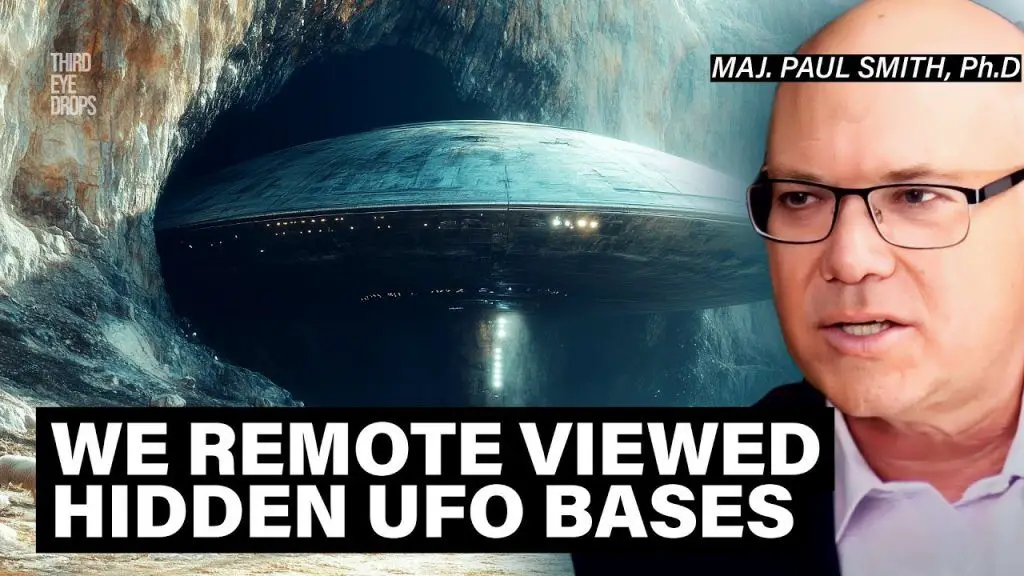
Dr. Paul H. Smith, a former U.S. Army intelligence officer and one of the original participants in the top-secret Stargate Program, has long stood at the crossroads of military-grade psychic research and consciousness exploration. In a recent in-depth conversation, he peeled back the layers on hidden UFO bases, the evolution of remote viewing (RV), and what it means for our understanding of human perception and non-local consciousness.
From Intelligence Officer to Psychic Spy
Dr. Smith’s entry into the world of psychic intelligence began in the early 1980s when he was recruited under mysterious circumstances while stationed at Fort Meade. With a background in Middle Eastern analysis and linguistic proficiency, Smith had no idea that his next assignment would involve learning how to transcend space and time to gather intelligence using only his mind.
After passing a series of psychological and personality tests, he was introduced to Coordinate Remote Viewing (CRV), a structured technique originally developed by artist and psychic Ingo Swann and physicist Hal Puthoff at Stanford Research Institute (SRI). The methodology allowed individuals to “view” distant targets by accessing information beyond ordinary perception — a concept once relegated to science fiction.
Stargate, Soviet Threats, and the CIA’s Role
The military’s interest in remote viewing began during the Cold War when U.S. intelligence agencies learned that the Soviets were investing millions in psychotronic research. The CIA, initially skeptical, began supporting experiments at SRI after Swann successfully influenced a shielded device in a lab — an event that reportedly defied conventional explanation.
Dr. Smith explains that remote viewing was formally integrated into U.S. Army intelligence operations in the late 1970s. The Stargate Project became a classified unit tasked with gathering actionable intelligence, ranging from hostage situations to potential foreign threats — sometimes including unconventional targets like hidden underground facilities.
The Typhoon Submarine Case: Proving It Works
One of the most compelling examples of RV’s success was the prediction of the Soviet Typhoon-class submarine. Remote viewer Joe McMoneagle, working blind, described a massive submarine under construction with missile tubes located in front of the conning tower — a design detail that contradicted naval norms.
The National Security Council initially dismissed the session, but months later, the Typhoon sub was launched — exactly as described. Ironically, this success was not officially acknowledged, contributing to the misconception that remote viewing had no real-world impact.
Pat Price, Hidden UFO Bases, and a Mysterious Death
Another central figure in remote viewing lore is Pat Price, a former police commissioner turned psychic. His sessions — particularly those involving four suspected alien bases (Mount Hayes, Alaska; Australia; Africa; and Spain) — remain controversial. What’s extraordinary is that multiple remote viewers, including Dr. Smith himself, unknowingly corroborated Price’s earlier findings when tasked to view Mount Hayes years later.
Price described alien-like entities operating underground facilities, and even sketched craft eerily similar to what modern witnesses call “Tic Tac” UFOs. He later died suddenly under suspicious circumstances. According to Price’s daughter, he had warned that if anything happened to him, it would be the KGB — a plausible theory given that there is no known method to shield against psychic surveillance, making psychic operatives like Price high-value targets.
Consciousness as a Non-Local Phenomenon
For Dr. Smith, the implications of remote viewing go far beyond espionage. The practice suggests that consciousness may be non-local, capable of existing independently of time and space. This idea has philosophical and metaphysical ramifications, challenging materialist assumptions and opening new doors into the study of mind and existence.
Remote viewing has produced results that imply the viewer can “bilocate,” experiencing presence both in the viewing room and at the distant target — including locations as extreme as the far side of the Moon. In one such case, Smith and other trained viewers described an artificial underground cavity on the Moon containing manta-ray-shaped craft, potentially biological in nature and seemingly aware of being observed.
Psionics, Classified Programs, and the Future of Human Potential
As new whistleblowers like David Grusch and Jake Barber come forward, alleging the existence of recovered alien craft and so-called “psionic assets,” Dr. Smith remains cautiously open. He draws parallels between these new terms and the military’s older term psychoenergetics, which encompassed remote viewing and similar phenomena.
While the Stargate program was officially shut down in 1995, Smith and others believe interest in consciousness-based intelligence gathering never truly ended. Some former insiders, like Skip Atwater, have hinted at the existence of successor programs.
Dr. Paul H. Smith remains one of the most grounded and credible voices in the world of psychic phenomena. His experience spans not only military intelligence but also deep philosophical inquiry into the nature of mind, space, and perception.
If the implications of remote viewing are real — and according to Smith, they very much are — then humanity is only beginning to understand its own untapped potential. Whether for intelligence gathering, interstellar exploration, or expanding our comprehension of consciousness itself, remote viewing stands as one of the most fascinating and misunderstood tools of the modern age.

Leave a Reply